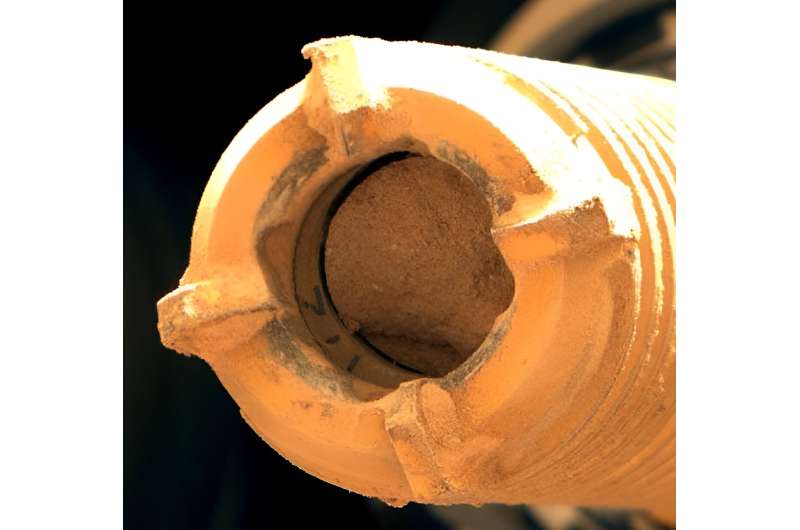A cylinder of rock inside the Perseverance rover’s drill bit.Image source: NASA
NASA recently announced that it is looking for new ways to return to Earth the cores drilled by the Perseverance rover in Jezero Crater on Mars. This has caused some anxiety among space scientists, who view the Mars Sample Return (MSR) mission as a cornerstone of plans to explore the solar system.
But when you consider the scientific and political stakes, it seems likely that NASA will move forward with this mission and make it a success.
A key conclusion of NASA’s review is that the MSR was built on an unrealistic budget and schedule. The cost is now expected to be $8.11 billion (£65.0-8.9 billion), compared with an initial estimate of $5.3 billion. This does not include ongoing investment by the European Space Agency (ESA), which is likely to be around €2bn (£1.7bn).
There are also concerns that the timetable for returning drill cores to Earth could be pushed back into the 2040s, beginning to hinder more ambitious visions of human missions to Mars.
Despite these obstacles, NASA remains committed to MSR as one of its highest science priorities. In fact, it remains the agency’s highest priority for planetary science in a decade.
NASA is serious about implementing the recommendations of its 10-year community survey and is unwilling to abandon them. ESA is also unlikely to want to lose the scientific investment it has made in MSR.
of great scientific importance
So why does the space science community consider MSR so important? Part of the reason is that these technologies are stepping stones for future human exploration. For example, the mission requires an ascent vehicle to launch samples into orbit to be captured by another spacecraft.
Perseverance has begun the first critical phase of the mission – drilling in Jezero Crater. This is the first of four stages. The next two stages will collect at least some of the drilled samples and launch them into orbit with the Mars Ascent Vehicle to be captured by ESA’s Return Orbiter. Capturing a football-sized return capsule in orbit around Mars is one of MSR’s key technical challenges. ESA plays an important role in this and is leading the development of return-to-orbit vehicles.
The final phase, assuming a successful landing at the Utah Test and Training Range, is a painstaking program of organic, geochemical and mineralogical analysis that will be conducted under strict containment conditions. This phase will deploy the best equipment our scientists have in laboratories around the world.
But these challenging steps come at a cost, and NASA is now proposing to lower the costs. For example, it can reduce the mass of an ascending vehicle. It has abandoned plans for a British-built Fetch rover to collect drill samples. Even the option of using a helicopter, as Ingenuity demonstrated at Mars 2020, carries risks – possibly Perseverance itself transporting the drill pipe to the ascent rocket.
But these financial savings come with scientific costs. In this case, the number of currently envisaged 30 drill cores (each about 6 cm long in a 15 cm tube) will be reduced to keep the ascent vehicle lightweight.
Actual samples from ancient deltas and thick lava flows drilled in Jezero Crater have been preserved in traces of hydrothermal alteration and have been stored on ships or dropped in warehouses. These precious cores represent the results of past Mars orbiter and lander missions, telling us where to land and accurately predicting what we will find.
Ultimately, the samples awaiting return to Earth offer our best chance of identifying traces of ancient life beyond Earth in the near future. It’s hard to imagine a more pressing mission for space science.
If Perseverance continues to work successfully – and its 12-year-old sister rover Curiosity, which I’m working on, suggests it will – then we have the tantalizing prospect of sampling the rim of Jezero Crater. This is a window into a new type of environment in Mars exploration: excavated deep crust, where ancient microbial life may have been protected from harsh surface radiation.
competition in china
There is another, less science-driven reason why NASA and the European Space Agency are keen to maintain their successful records in Mars exploration.
The Apollo program was driven by Cold War competition with the Soviet Union. Sadly, new collaborations with the Russian space agency Roscosmos and realizing the full potential of space exploration in a more peaceful geopolitical environment are not currently possible.
Roscosmos can no longer carry out reliable Maritime Silk Road missions alone. ESA’s Rosalind Franklin Mars rover was originally scheduled to launch on a Soyuz rocket in 2023, but the mission was quickly reconsidered following the Ukrainian invasion.
China now has solid plans for a Mars sample return mission called Tianwen-3. China’s space agency hopes to launch in 2028, with the lander and ascender launched separately. If this challenging timetable is met, the sample could be returned to Earth in 2031.
In 2020, I think a new era of cooperation between China and the West is possible. But four years on, I wonder if the history of the rivalry will repeat itself.
MSR is needed to answer some of the most important questions about habitable environments on Mars and beyond Earth. But it also looks set to become another symbol of competition in space. That said, that’s probably a big reason why it does succeed.
provided by The Conversation
This article is republished from The Conversation under a Creative Commons license. Read the original article.![]()
citation: NASA to overhaul mission to return samples from Marshare, explains why it must and will go ahead (2024, April 23) Retrieved April 24, 2024, from https://phys.org/news/ 2024-04-nasa-overhaul-mission-samples-mars.html
This document is protected by copyright. No part may be reproduced without written permission except in the interests of fair dealing for private study or research purposes. Content is for reference only.
#NASA #overhaul #mission #return #samples #Machel #heres #continue
Image Source : phys.org
